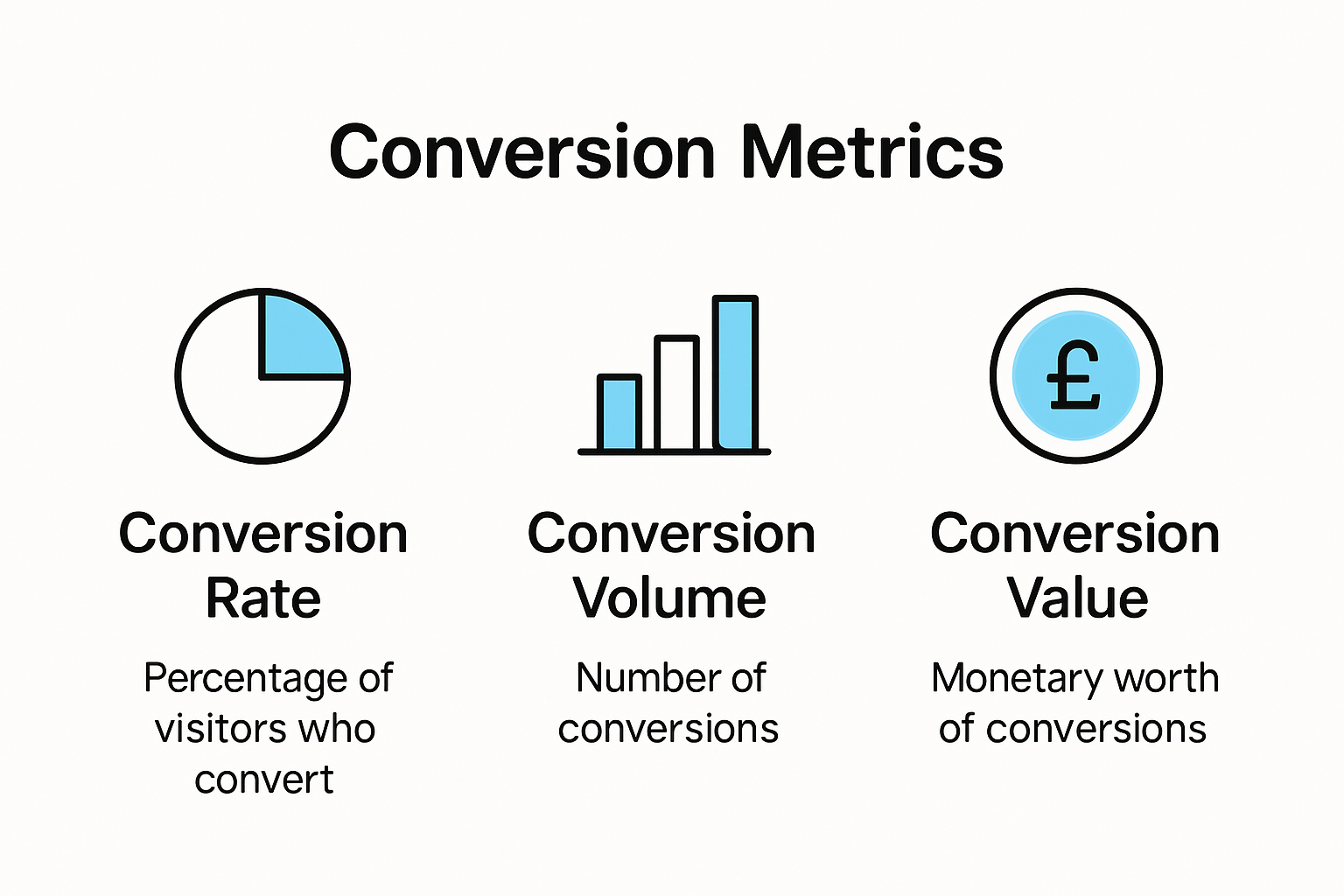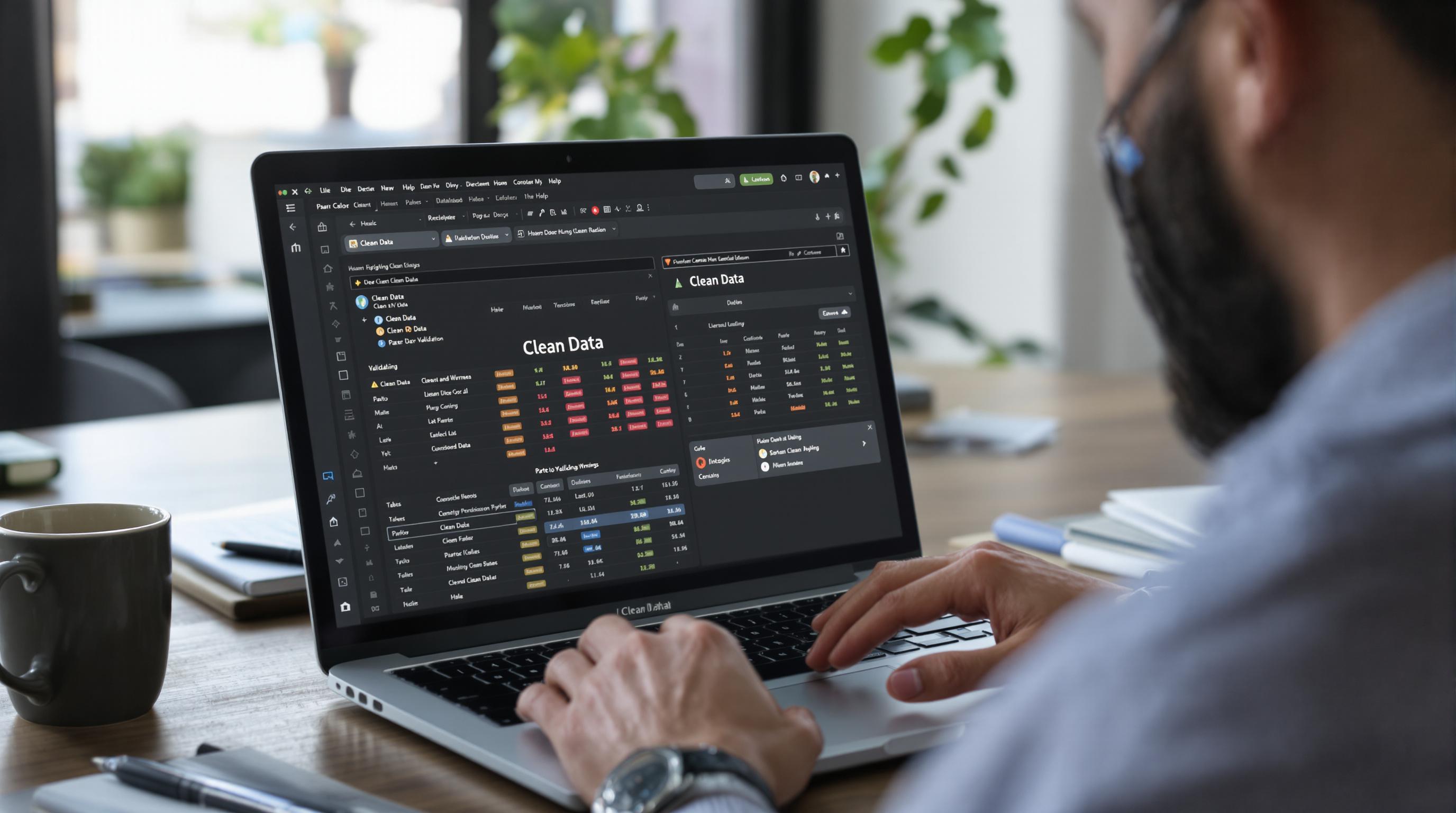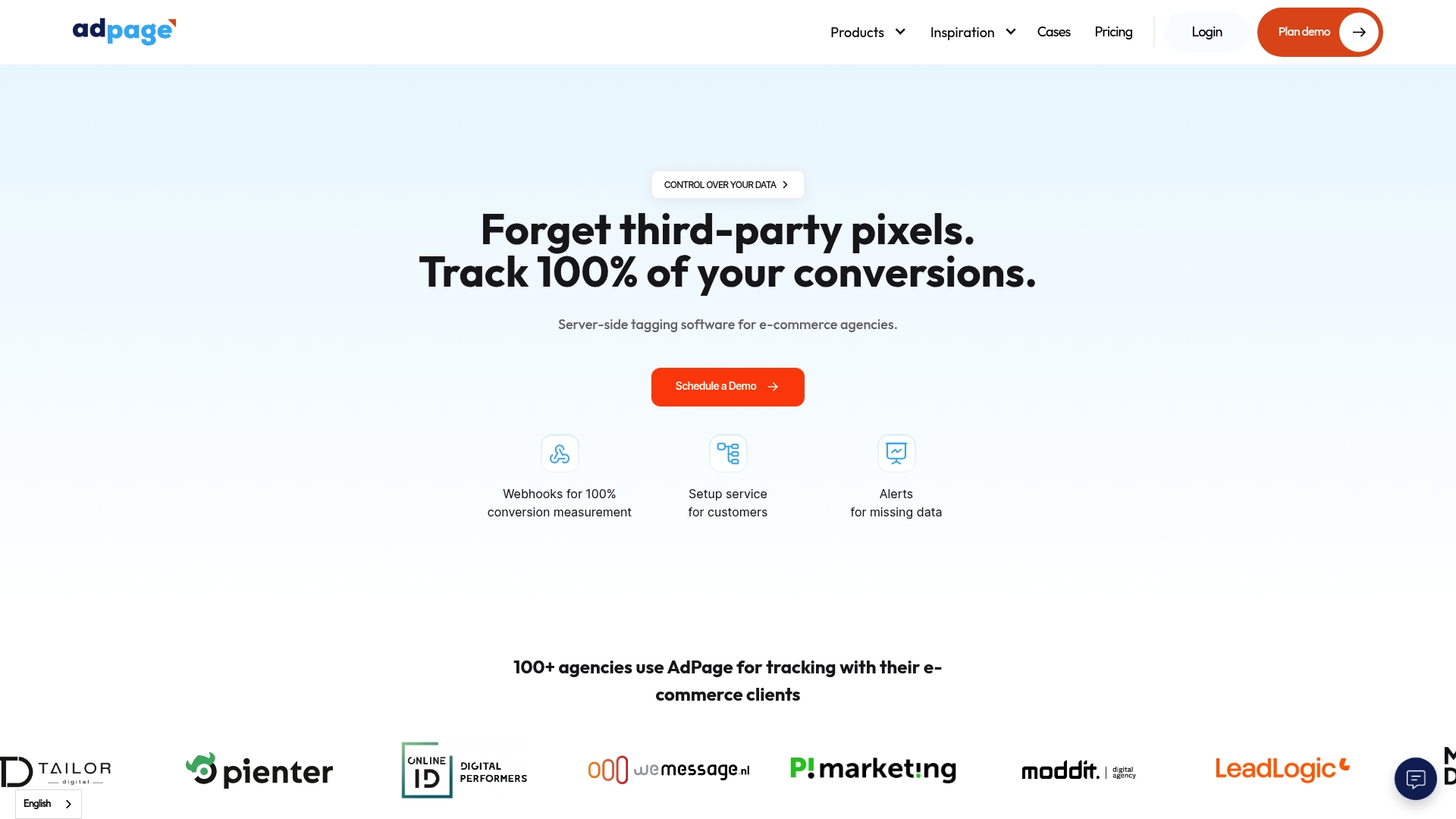Conversion data holds the key to unlocking better results for any business, yet many still rely on surface-level metrics and fragmented tools. Shockingly, server-side tracking can capture up to 100 percent of user interactions, wiping out the blind spots that leave most marketers guessing. The surprising part is that mastering comprehensive analytics in 2025 is less about technical complexity and more about asking the right questions at each stage of the user journey.
Table of Contents
- Understanding Conversion Data Metrics
- Key Steps To Analyze Conversion Data Effectively
- Top Tools For Conversion Data Analysis In 2025
- Actionable Strategies To Optimize Your Conversion Rate
Quick Summary
| Takeaway | Explanation |
|---|---|
| Core Conversion Metrics are Essential | Understanding key metrics such as conversion rate, conversion volume, and conversion value is crucial for effective analysis and optimization of user engagement. |
| Data Preparation is Key | Rigorous data cleaning and validation processes are necessary to ensure accuracy and reliability of conversion data analysis, enabling better insights. |
| Leverage Advanced Analytics Tools | Utilizing enterprise-level analytics platforms and specialized conversion tracking solutions helps marketers gain deeper insights and understand complex user interactions. |
| Implement Personalization Strategies | Hyper-personalization through dynamic content and behavioral segmentation can significantly enhance user experience and improve conversion rates. |
| Adopt Precision-Driven Experimentation | Systematic A/B testing with a focus on statistical significance and hypothesis development allows businesses to understand behavior and effectively optimize conversion rates. |
Understanding Conversion Data Metrics
Converting raw website data into meaningful insights requires a strategic approach to understanding conversion metrics. Businesses seeking to optimize their digital performance must dive deep into the nuanced world of data analysis, transforming numbers into actionable intelligence.
Core Conversion Metrics Every Marketer Must Know
Successful conversion tracking starts with identifying the most critical metrics that reveal user behavior and performance. Conversion rate sits at the heart of this analysis, representing the percentage of visitors who complete a desired action. Research from Google Analytics suggests that understanding this metric goes beyond simple percentage calculations.
Key conversion metrics include:
- Conversion Volume: Total number of completed conversions
- Conversion Value: Monetary worth of each conversion
- Conversion Path: User journey leading to the final action

Advanced Analytics for Precise Measurement
The meta-analysis accelerator research highlights the importance of precise statistical data handling. Advanced analytics tools now enable marketers to track complex user interactions with unprecedented accuracy. This means moving beyond surface-level metrics to understand the intricate dynamics of user engagement.
Server-side tracking becomes crucial in this context, providing a more comprehensive view of conversion data. By capturing 100% of user interactions, businesses can eliminate data blind spots that traditional client-side tracking often creates. This approach ensures more reliable insights, helping organisations make data-driven decisions with greater confidence.
Interpreting Conversion Signals
Interpreting conversion data requires a nuanced understanding of user behavior. It is not just about collecting numbers but understanding the story behind those numbers. Sophisticated analytics platforms now offer visitor identity services and detailed reporting tools that transform raw data into strategic insights.
Marketing agencies and e-commerce businesses must look beyond basic conversion rates. They need to examine:
- User engagement patterns
- Drop-off points in the conversion funnel
- Contextual factors influencing user decisions
By adopting a holistic approach to conversion data analysis, businesses can develop more targeted strategies that directly address user needs and preferences. The goal is not just to track conversions but to understand and ultimately improve the entire user experience.
To aid your understanding, here's a table summarizing the core conversion metrics every marketer should track and their purposes:
| Metric | Definition | Purpose |
|---|---|---|
| Conversion Rate | Percentage of visitors completing an action | Measures effectiveness in driving conversions |
| Conversion Volume | Total number of conversions | Quantifies overall conversion wins |
| Conversion Value | Monetary worth of each conversion | Values the financial impact of conversions |
| Conversion Path | User journey to conversion | Analyses steps leading to conversion |
Key Steps to Analyzing Conversion Data Effectively
Navigating the complex landscape of conversion data analysis requires a systematic and strategic approach. Marketing professionals and e-commerce strategists must implement a structured methodology to transform raw data into meaningful insights that drive business growth.
Preparing and Cleaning Your Conversion Data
Harvard Business School Online recommends starting with rigorous data preparation. This initial stage involves cleaning and validating data to ensure accuracy and reliability. Effective data cleaning means removing duplicate entries, correcting inconsistent formatting, and eliminating outliers that could skew analytical results.
Key data preparation techniques include:
- Data Validation: Checking for completeness and accuracy of collected information
- Standardization: Ensuring consistent data formats across different sources
- Error Removal: Identifying and eliminating anomalous or incorrect data points
Server-side tracking provides a significant advantage in this process by capturing comprehensive user interactions and minimizing data collection errors. This approach ensures a more robust dataset for analysis.
The following table outlines the core steps for effective conversion data preparation and their objectives:
| Step | Description | Objective |
|---|---|---|
| Data Validation | Verifying data completeness and correctness | Ensures accuracy and reliability |
| Standardization | Unifying data formats from various sources | Enables consistent analysis |
| Error Removal | Identifying and eliminating outliers or anomalies | Prevents skewed results and improves quality |
Developing a Strategic Analysis Framework.
Transforming data into actionable insights requires a clear analytical framework. Businesses must move beyond passive data collection to active interpretation. Research from Digital Analytics Association suggests developing a structured approach that aligns data analysis with specific business objectives.
This framework should incorporate:
- Clearly defined conversion goals
- Specific performance metrics
- Contextual understanding of user behavior
- Segmentation strategies for deeper insights
Marketing teams need to establish precise questions they want the data to answer. This might include understanding customer drop-off points, identifying high-performing conversion channels, or uncovering patterns in user engagement.
Advanced Conversion Data Interpretation Techniques
Advanced data interpretation goes beyond surface-level metrics. Sophisticated analysis involves complex statistical techniques and contextual understanding of user interactions. Businesses must develop a multidimensional view of their conversion data, looking beyond simple numerical representations.
Effective interpretation techniques include:
- Cohort analysis to understand user behavior over time
- Funnel analysis to identify conversion barriers
- Predictive modeling to forecast potential conversion trends
Implementing these techniques requires a combination of technological tools and analytical expertise. Marketing agencies and e-commerce businesses must invest in advanced analytics platforms that offer comprehensive reporting and visitor identity services.
The ultimate goal of conversion data analysis is not just to collect numbers but to generate insights that drive strategic decision-making. By approaching data with a systematic, comprehensive methodology, businesses can unlock powerful insights that translate directly into improved performance and enhanced user experiences.

Top Tools for Conversion Data Analysis in 2025.
The rapidly evolving digital marketing landscape demands sophisticated tools that can provide deep insights into conversion data. As we approach 2025, businesses must leverage cutting-edge technologies that offer comprehensive analytics capabilities to stay competitive.
Enterprise-Level Analytics Platforms
Apache Spark emerges as a powerful open-source data processing engine capable of handling massive datasets with unprecedented efficiency. For marketing agencies and e-commerce businesses, this means the ability to process complex conversion data in real-time, uncovering intricate patterns that traditional analytics tools might miss.
Key features of advanced analytics platforms include:
- Scalable Data Processing: Handling large volumes of conversion data
- Real-Time Analytics: Instant insights into user behavior
- Machine Learning Integration: Predictive conversion modeling
Server-side tracking technologies complement these platforms by ensuring comprehensive data collection, eliminating blind spots in conversion measurement.
Specialized Conversion Tracking Solutions.
Google Analytics continues to be a cornerstone tool for digital marketers, offering robust tracking capabilities. However, 2025 demands more nuanced approaches to data analysis. Qualtrics XM represents a new generation of experience management platforms that go beyond traditional analytics.
Advanced conversion tracking tools now provide:
- Visitor identity services
- Granular conversion funnel analysis
- Consent management features
- GDPR compliance mechanisms
Emerging Technologies in Conversion Analysis
The future of conversion data analysis lies in intelligent, context-aware solutions. Artificial intelligence and machine learning are transforming how businesses interpret user interactions. Tools are moving beyond simple metric reporting to provide predictive insights and actionable recommendations.
Cutting-edge technologies are introducing:
- Automated insight generation
- Contextual behavior prediction
- Cross-platform conversion tracking
- Advanced segmentation capabilities
Marketing professionals must invest in tools that offer more than just data collection. The ideal conversion analysis platform provides a holistic view of user journeys, combining quantitative metrics with qualitative insights.
Choosing the right tool requires careful consideration of specific business needs, data complexity, and integration capabilities. As conversion tracking becomes increasingly sophisticated, businesses that leverage these advanced technologies will gain a significant competitive advantage in understanding and optimizing their digital performance.
Actionable Strategies to Optimize Your Conversion Rate.
Improving conversion rates requires a strategic and data-driven approach that goes beyond surface-level modifications. Marketing professionals must implement sophisticated techniques that systematically enhance user experience and drive meaningful engagement.
Precision-Driven Experimentation Techniques
Research from the National Institutes of Health highlights the importance of systematic experimentation in conversion rate optimization. A/B testing emerges as a powerful methodology for understanding user behavior and making informed design decisions.
Key experimentation strategies include:
- Hypothesis Development: Crafting specific, measurable hypotheses about user interactions
- Controlled Testing: Implementing variations with minimal variables
- Statistical Significance: Ensuring results are mathematically reliable
Server-side tracking becomes crucial in this context, providing comprehensive data capture that eliminates potential experimental blind spots. By tracking 100% of user interactions, businesses can develop more nuanced and accurate testing strategies.
User Journey Mapping and Conversion Funnel Analysis.
Understanding the complete user journey requires a holistic approach to conversion analysis. Marketing agencies must look beyond individual touchpoints to comprehend the entire path a user takes from initial engagement to final conversion.
Effective user journey mapping involves:
- Identifying critical interaction points
- Detecting potential friction areas
- Understanding user motivation at each stage
- Developing targeted interventions
Advanced analytics platforms now offer sophisticated funnel visualization tools that help businesses pinpoint exactly where potential customers might be dropping off and why.
Personalization and Contextual Optimization
The future of conversion rate optimization lies in hyper-personalization. Businesses must move beyond generic approaches to create tailored experiences that speak directly to individual user needs and preferences.
Key personalization strategies include:
- Dynamic content adaptation
- Behavioural segmentation
- Predictive user experience design
- Contextual recommendation engines
Marketing professionals should leverage visitor identity services and advanced analytics to create increasingly sophisticated personalization strategies. The goal is to create an experience so intuitive and relevant that conversion becomes almost effortless.
Successful conversion rate optimization is not a one-time project but a continuous process of learning, testing, and refinement. By adopting a data-driven, user-centric approach, businesses can create increasingly effective digital experiences that not only convert but also build long-term user trust and engagement.
Frequently Asked Questions
What are the core conversion metrics I should track?
Key conversion metrics to track include conversion rate, conversion volume, conversion value, and conversion path. These metrics provide insights into user behaviour and performance, helping to optimise digital marketing strategies.
How can I prepare and clean my conversion data effectively?
To prepare and clean conversion data, start with data validation to ensure accuracy, standardization for consistent formatting, and error removal to eliminate outliers. These steps will enhance the reliability of your analysis.
What tools are recommended for analyzing conversion data in 2025?
For analyzing conversion data in 2025, recommended tools include enterprise-level analytics platforms like Apache Spark, specialized conversion tracking solutions such as Google Analytics and Qualtrics XM, and emerging technologies leveraging AI and machine learning for predictive insights.
How can I utilise A/B testing to improve my conversion rates?
To utilise A/B testing effectively, develop specific hypotheses about user interactions, conduct controlled tests with minimal variables, and ensure statistical significance in results. This systematic approach provides valuable insights for optimising user experiences.
Ready to See Every Conversion and Unlock True Growth?
If you have been grappling with incomplete tracking, blind spots in your conversion funnel, or unreliable analytics, you are not alone. This article explored how data gaps and fragmented systems create barriers to real optimization. What if you could capture 100 percent of user interactions, solve attribution uncertainties, and make every decision based on true, comprehensive insight?

With AdPage, you gain access to advanced server-side tagging, visitor identity services, and seamless integration with platforms like Shopify and WooCommerce. Our solution lets you monitor every conversion, overcome data loss, and maintain GDPR compliance. Whether you are running campaigns for clients or growing your own online store, AdPage is your ally for turning raw data into actionable results. Explore why leading marketing agencies and e-commerce businesses trust AdPage's conversion tracking platform and transform how you analyze conversion data today. Visit AdPage now to experience precision and clarity in every metric.



.png)
